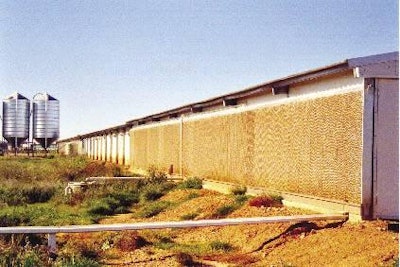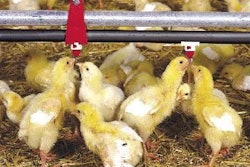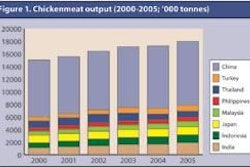
Broiler housing in Australia has made significant technological advances in the past decade. The era of housing in naturally ventilated sheds has passed and now larger and more sophisticated tunnel-ventilated housing is the accepted method of growing meat chickens.
This is evident on a broiler farm housing 400,000 birds at Dublin, about 50 kilometres north of Adelaide in the state of South Australia.
Part owner of the business, Paul Rymer, commented, "This broiler farm was established in the late 1980s with naturally ventilated sheds with fans and cooling facilities to combat high temperatures. We purchased the farm in year 2000 and immediately set about upgrading the sheds to tunnel ventilation, which we considered a housing system that would give improved bird performance at an economical cost. I might say we have not been disappointed with our decision.
"The farm has been expanded to ten houses with a floor area of 20,572m2. A further 10,000m2 is planned for this year. The most recently built houses incorporate the latest technologies available and I consider getting close to the ultimate at this stage in chicken housing."
The new houses have features that optimise the performance of chicken growing in the Mediterranean climate experienced in this area. Summer daily temperatures can reach 45 C and last for up to a week, while night-time temperatures can drop below freezing. However, the low humidity makes it ideal for broiler growing.
Tunnel ventilation allows modification of these extremes to provide environmental conditions to suit the birds' requirements throughout all stages of growth. The main feature of this type of house is the ability to modify the hot summer temperatures effectively.
The accumulation of knowledge over the past 30 years in rearing chickens has influenced Mr Rymer to construct houses of this design because they can provide ideal conditions for growing chickens. Ventilation and when necessary, cooling is provided by fans pulling air through the entire length of the shed.
House design
Mr Rymer explained the dimensions and facilities of the houses. All are steel-framed and measure 162 metres long by 15 metres wide and walls 2.6 metres high, made of 50mm polystyrene sandwich panel board. A lower wall supporting the panels is 60cm high and made of high pre-formed concrete slabs. The outside of the walls is white with the internal surface flat green to reduce light reflection. The roof is zincalume a type of steel sheeting with a coating of aluminium, zinc and silicon for greater resistance to corrosion covering a 75mm blanket of PVC insulation lined with foil supported by 100mm mesh.
"We gave a lot of consideration to the type of equipment we needed in the sheds to make them operate efficiently," commented Mr Rymer.
Eight fans at the end of the shed provide a capacity of 256,000 cubic feet/minute (7250m3/minute), creating a maximum air speed of 2.6 metres/second. Small vents are fitted in each bay on both sides of the house to provide minimum ventilation when required, operated by a central actuator.
At the other end of the house, shed inlet curtains on each side are 25m long and 1.8m deep. The cooling capacity pad is also 28 metres long with single pads measuring 1830mm x 600mm x150mm with 45/15-degree flutes for maximum cooling to be achieved.
For all these facilities to operate efficiently, they have installed an advanced controller and software control system that allow precision but also flexibility to maintain control of temperature, ventilation and humidity in the house at all times. However, this control system requires good management so that it is fine-tuned to suit the birds and their environmental requirements.
Based on past experience, a drinking system was selected. It provides five lines, centrally split with the nipples having a 360 degree rotation and a flow rate of 120ml/minute. There are four lines of centrally fed shallow pan feeders, allowing birds easy access to feed. Heating for young chicks is provided by liquid petroleum gas heaters.
The cost of each house exceeded $400,000 (AUD; around US$320,000) but this was considered well worthwhile while the Australian broiler industry is growing so strongly.
Management of the birds
The sexed broiler chicks are placed on chopped straw litter at a stocking density of 18 birds/m2 during summer and 20 birds/m2 for the rest of the year.
Mr Rymer explained the growing procedure, "Initially, only half the shed is used for brooding, with three heaters. As the birds grow and take up about three-quarters of the house, the fourth heater comes into play until the whole shed is taken over by the birds. Feed is placed on paper covering the litter for easy access. The paper is left to break down after the birds use the feeders. About one tonne of feed is placed on the paper in each house."
There are two rows of 25-watt incandescent lamps, four metres apart down the length of the shed. These provide the young birds in the early stages of growth with 4-5 lux light intensity, gradually reducing to 1.5 to 2 lux after brooding. They find this intensity sufficient to encourage eating and drinking during brooding and the gradual reduction helps to keep the birds calm.
Three temperature sensors in each house provide valuable information for the operation of the control panel. Small vents on the sides of the house provide minimum ventilation mainly when the birds are young but they are also used at other times when necessary.
As the birds grow, the fans come into operation more and when temperatures soar, the air being dragged into the house for ventilation goes through the cooling pads and is tunnelled through the length of the shed. This is a critical time because the outside temperature can reach 45 C. Fortunately, these hot periods are usually accompanied by low humidity and the dry air can be forced through the cooling pads to provide cool air for ventilation, enhancing the birds comfort. The house temperature can be reduced by up to 15 C by this method, which proves the value of this type of shed.
Water usage is critical during these hot spells about 100,000 litres/day are required for each house.
The environmental control panel also allows more precise modification of the internal conditions, particularly during hot weather.
Bird performance
How the birds perform is the measure of the value of building this hi-tech broiler housing. Mr Rymer explained that the results achieved are up to their expectations, "Although our farm is isolated from other poultry farms, audited biosecurity and quality assurance programmes are in place to prevent disease and ensure efficiency of the farm. Under contract, the farm is run on an all-in, all-out' basis, again to ensure disease control. There is a 63-day bird replacement cycle. It takes four collections by the processor to clear the house. Females weigh at least 1.6kg, the males, up to 3.4kg. Each batch of birds is assessed on its performance, which should be the standard practice for any commercial broiler farm. Corrected to a live-weight of 2.45kg, we regularly achieve a feed conversion ratio of 1.77 at an average of 38.5 days."
It is evident that efficient environmental management is essential to grow broiler chickens under the challenging climatic conditions in this part of Australia. The design and operation of the tunnel-ventilated houses play a significant role in fulfilling this aim cost-efficiently.















